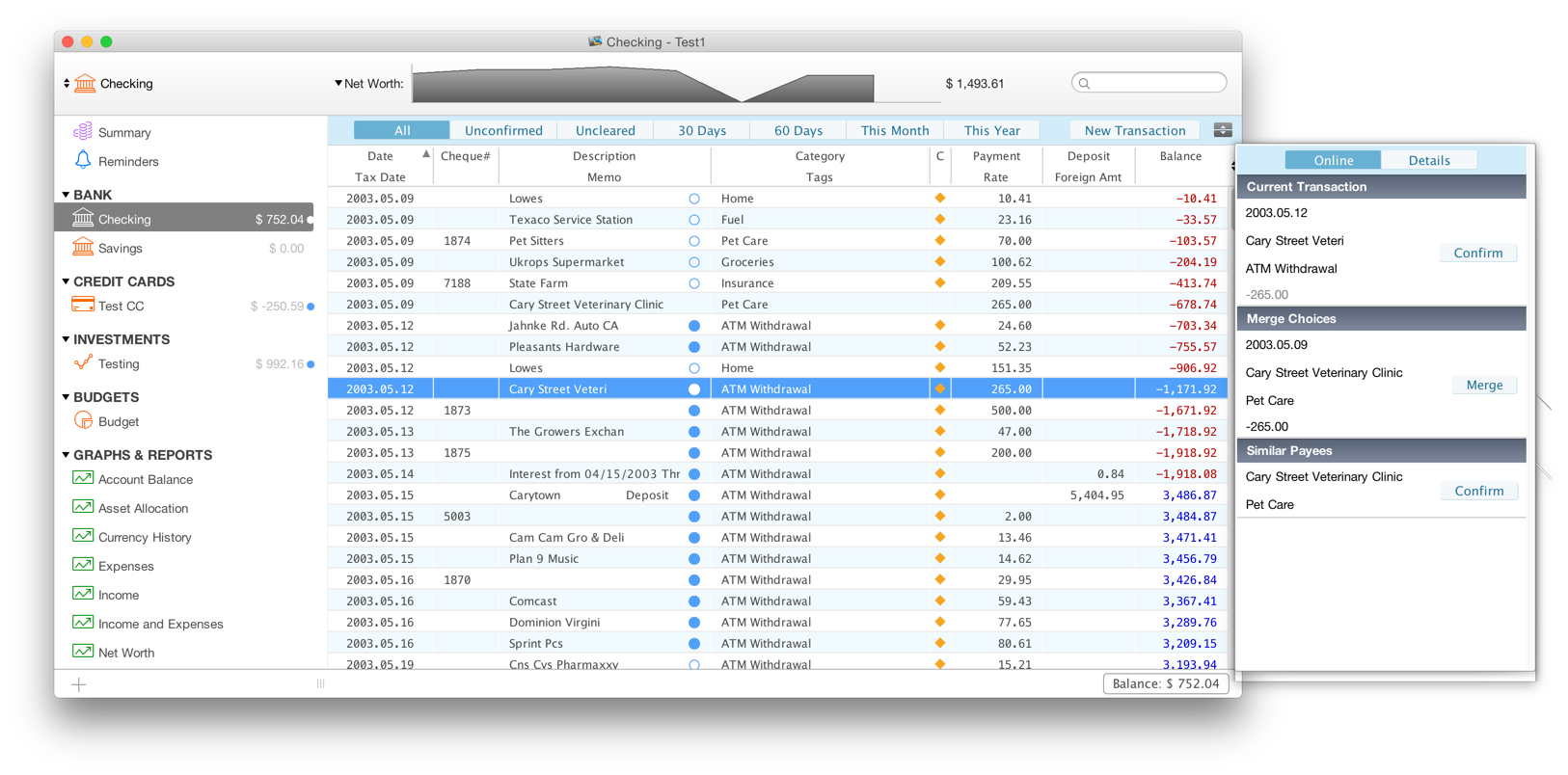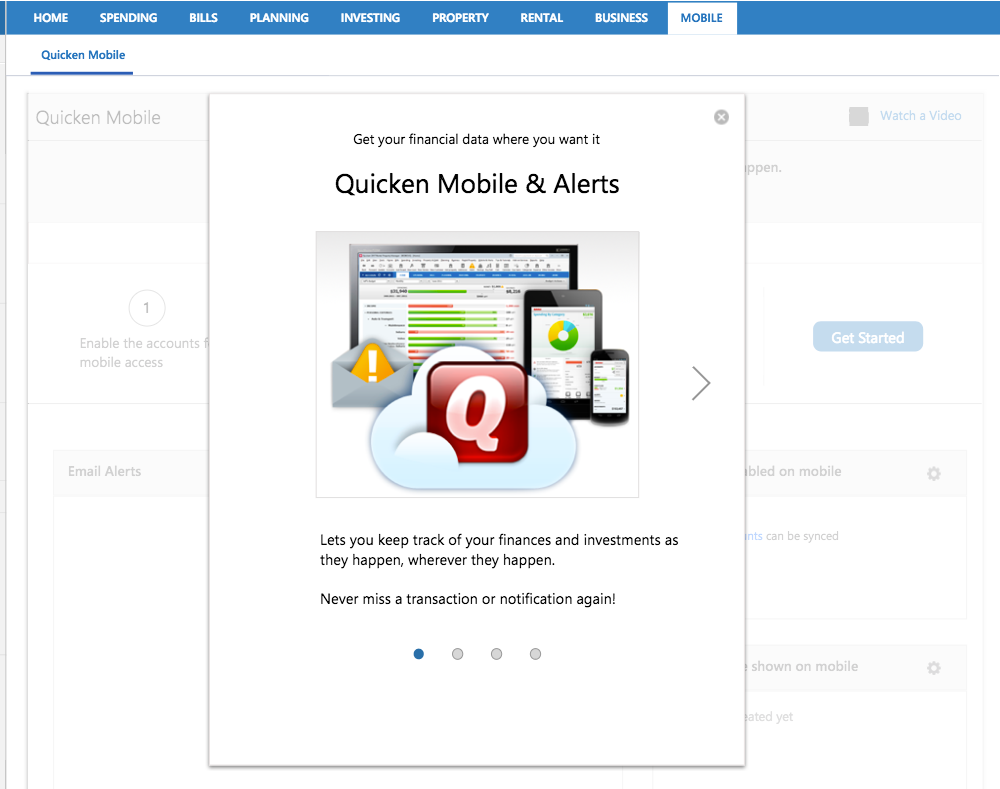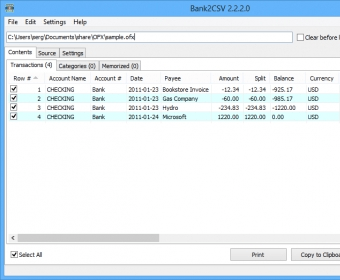
Skip to end of metadataGo to start of metadata
- Quicken
- Quicken For Mac Free Trial
- Quicken Deluxe For Mac
- Quicken For Mac Pro
- Quicken For Mac Not Downloading Transactions
- Quicken For Mac Air
A transfer is a special transaction used when you are recording a transaction between two accounts you track in Quicken. That is, any transaction that is not income or expense, just the movement of money from one account to another. Some examples of transfer transactions include:
Quicken for Mac is a native app for Apple iOS. It’s actually a completely different product than it’s Windows counterpart. It’s also been rewritten a couple of times to work better within the limitations of the Apple iOS. Pros and cons of Quicken for Mac. No good Quicken for Mac review would be complete without a pros and cons list.
- Movement of funds between a checking account and a savings account
- Movement of funds between a checking account and a brokerage account
- A credit card payment (movement of funds from a checking account to a credit account)
- Cash advances from a credit card account to a checking account
- Loan payments from a checking account to a liability account that tracks the balance of the loan
- 'Partial Download (-28) 1 new transactions downloaded (there may be more transactions to download). Webpage is Currently Unavailable.' No transactions have been downloaded. Been using Quicken Connect for years with no problem. Now USAA does NOT accept Direct Connect.
- Quicken has been around for a long time. There are Quicken versions for Windows and Mac. Updates to Quicken for Mac were sporadic at best until Intuit sold the software to H.I.G. But now that the Quicken product line is under new ownership, the Mac side hasn't been neglected as much. Still, there are differences between the two products.
- Security prices can be set in Preferences to update when you start Quicken Mac.or from the Investing screen by selecting the circle with the arrow. Or using the same One Step Update you use to download transactions.
- Jun 05, 2020 For something that’s human-readable, you can still download your statement as a PDF. In Step 4 above, instead of tapping Export Transactions, tap Download PDF Statement. Here’s how you can use the various formats Apple Card can now export: QFX: Import into Quicken by choosing File Import Bank or Brokerage File.
Quicken considers a transfer to be neither an income nor an expense transaction. As such, transfers are excluded from Spending and Income reports and charts.
Suppose you are moving money from checking to savings. You did not spend (you still have the cash), and you did not earn income (you have same net worth you had before the transfer). As such, these transactions are neither income nor expenses.
Two types of transfers are supported in Quicken


You can use the special Transfer category to record transfers or you can do a Linked Transfer which actually creates a relationship between two transactions in separate account. Both methods have pros and cons. You can use the method that makes the most sense for you or even use both methods.
Using the Transfer category
Transfer category
You will find a Transfer category in Quicken's category list. This special category is considered neither income or expense. Transactions assigned to the Transfer category are excluded from income and expense reports and charts (because it records the movement of money between two accounts that belong to you.)
Assigning the Transfer category (or the Transfer subcategory 'Credit Card Payment') does not create or imply a relationship between any other transactions in Quicken, such as transactions in a different account.
Appropriate uses of the Transfer category would include:
Quicken
- Transactions that move money between two accounts that you track in Quicken (such as Checking to Savings). Just assign the Transfer category to both the outgoing checking transaction and in incoming savings transaction. Assigning a specific account name is not required.
- Transactions that move money between an account you track in Quicken and an account you do not track in Quicken. For example, if you added your Checking account to Quicken but did not add your Savings account, using the Transfer category ensures that this transaction is still considered 'neutral' (neither income nor expense) in reports and graphs.
- Transactions that move money between checking accounts and brokerage accounts.
- Credit card payments (there is a special Transfer subcategory just for credit card payments--see also the help topic on credit cards below.
Inappropriate uses of the Transfer category might include:
- A transfer of money to a friend or relative as a gift.
- A transfer of money to a third party pay a bill or expense.
- a transfer of money to you from a third party, such as direct deposit of your paycheck or payment for services of goods.
- In short, any account-to-account 'transfer' where you gain income or incur a real expense is probably best handled by the appropriate income or expense category--not a transfer.
Quicken For Mac Free Trial
Using a Linked Transfer
Using a Linked Transfer
A Linked Transfer creates an direct relationship between two transactions in different accounts tracked in Quicken. (If you've used older versions of Quicken for Mac or Quicken for Windows, this the classic Quicken transfer you've used in those products.)
Just like the Transfer category, a Linked Transfer is considered neither income nor expense and is excluded by default from spending reports.
It's really two transactions.
When you create a Linked Transfer in the source account (as described below) you simultaneously create a new transaction in the destination account.
For example, if you created a Linked Transfer in your Checking account for $100 and choose My Savings in the transfer column, you will find a deposit transaction for $100 in the My Savings register.
NOTE: If you download transactions and then create the Linked Transfer after you've download both accounts (e.g. the Checking and My Savings from the example above), the transaction in the destination account will still be created. This could result in unexpected duplicates. Review your source/destination accounts and manually match your Linked Transfer transaction (drag-and-drop the matching downloaded transaction onto the transfer) or delete the downloaded transaction.
If you primarily download transactions, you might try using the Transfer Category option (as it will not result in new transactions being created in this way).
Finally, since Quicken supports the categorization of a Linked Transfer, the special Transfer category is automatically applied to Linked Transfer transactions. This can be changed if needed (for unique cases when you might do want to consider the transaction as income or expense). If you do change the category, then that transaction will be included in category-based reporting as appropriate.
To create a Linked Transfer
- Select the source account from the Accounts section of the sidebar.
- Create a new transaction (Click the New icon in the register toolbar or type ?N).
- Enter information about the transaction.
- Enter the name of the destination account in the Transfer column.
- If you don't see the Transfer column: Click the Columns icon in the register toolbar (or control + click the column header) and turn on the transfer column.
- Click Save or hit the Enter key to complete the transaction.
Handling credit card payments
Credit card payment transfers
Quicken considers a transfer to be neither an income nor an expense transaction. As such transfers are excluded from Spending and Income reports and charts.
Suppose you are moving money from checking to savings. You did not spend (you still have the cash), and you did not earn income (you have same net worth you had before the transfer). As such, these transactions are neither income nor expenses.
The same logic applies to credit card payments (when you track your credit cards in Quicken, which is highly recommended). Your credit card account already contains a record of all your expenses (the credit card transactions). When you pay your credit card bill from your checking account, you do not want the entire payment amount to be considered an expense because this would cause you to double count your expenses.
For example: If you have $100 worth of charges on your credit card, which are tracked in Quicken using a credit card account, those transactions are already categorized as expenses and will show in Spending reports and charts (dining, entertainment, fuel, etc.).
If you then pay your bill in full with $100 from your checking account, you should consider this payment to be a transfer, not expense. Considering it an expense would incorrectly show you had $200 worth of spending. Instead you are transferring funds from a checking account to a credit card account.
The exception to this rule is if you do not pay your credit cards in full each month. In this case you are incurring an interest expense and should track the interest as an additional expense. If your financial institution includes your interest payment as a unique transaction within the downloaded transactions, you can just categorize that transaction as an expense. If the financial institution does not show the interest as a 'transaction' (many do not), then you can split your credit payment--with the interest portion assigned an expense category and the remaining payment assigned as a transfer.

Splits and transfers
A transfer can be part of a split
A split transaction can include a transfer. It's handled just like any other split line item.
For example, you may want to transfer some of your paycheck into a retirement account. Or you might want to transfer the portion of your mortgage payment that goes toward the loan principal into a liability account that tracks the loan balance, and assign an expense category to the interest portion of the payment. For these cases, just create a split transaction and make one (or more) of the split lines a transfer by selecting the appropriate account from the Transfer column in the split window.
Quicken Deluxe For Mac
Related topics
Download Quicken 2017 v4.6 for Mac free latest version offline setup. Intuit Quicken 2017 v4.6 for Mac is a professional application to manage all the personal finances and provides a variety of powerful tools to manage the income.
Quicken 2017 v4.6 for Mac Review
A professional application for the users to deal with personal finances and provides a convenient way to organize the income and expenses. It is very easy to use application with a variety of powerful tools for finance, budgeting, and investment. It is a comprehensive application to manage and access the accounts from just one place.
Moreover, the application can manage the financial transactions as well as helps the users to pay the bills in time and deal with all the financial transactions, bank accounts, credit cards, retirement accounts, and various other financial matters.
Quicken For Mac Pro
The users can easily track the performance as well as generate different reports and charts. It focusses on the budget and the helps the users to easily handle all the financial matters without getting in any financial crisis. Customize the plans automatically and perform different other operations with minimum efforts. All in all, it is a reliable application to manage finances.
Features of Quicken 2017 v4.6 for Mac
Some of the features of Quicken 2017 are:
- Powerful application for managing personal finances
- Easy to use application with a wide range of tools
- Manage finance, investments, budgeting and more
- Access and manage all the accounts within one application
- Check all the personal expenditure and compare with income
- Generate different reports and compare the details
- Organize and categorize the financial transactions
- Paying the bills any time and manage the bank accounts
- Deal with all the credit and debit cards as well as retirement accounts
- Focusses on the budget and make different transactions
- Focusses on saving more money for future
- Completely customizable environment and much more
Quicken For Mac Not Downloading Transactions
Technical Details of Quicken 2017 v4.6 for Mac
- File Name: Intuit_Quicken_2017_v4.6.4_macOS.zip
- File Size: 34 MB
- Developer: Intuit
System Requirements for Quicken 2017 v4.6 for Mac
- Mac OS X 10.11 or later
- 1 GB free HDD
- 2 GB RAM
- Intel Core 2 Duo or higher
Quicken For Mac Air
Intuit Quicken 2017 v4.6 for Mac Free Download
Download Intuit Quicken 2017 v4.6 latest version offline setup for Mac OS X by clicking the below button. You can also download Intuit QuickBooks v17.2
